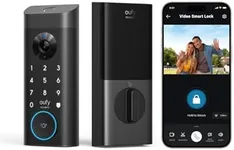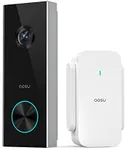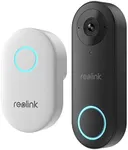Buying Guide for the Best Video Doorbells
Choosing a video doorbell can make your home safer and more convenient, but with so many options, it’s important to know what features matter most for your needs. Start by thinking about where you’ll install it, how you want to use it, and what kind of devices you want it to work with. Understanding the key specifications will help you find a video doorbell that fits your lifestyle and gives you peace of mind.Video ResolutionVideo resolution refers to how clear and detailed the video footage from your doorbell will be. Higher resolution means sharper images, which can help you recognize faces or read small details like package labels. Common resolutions include 720p (HD), 1080p (Full HD), and 2K or higher. If you just want to see who’s at the door, 720p may be enough, but for clearer images and better security, 1080p or higher is recommended. Choose based on how important image clarity is for your needs and whether you want to be able to zoom in on footage.
Field of ViewField of view describes how wide an area the camera can see. It’s measured in degrees, with wider angles capturing more of your porch or entryway. Typical ranges are from about 120° to 180°. A wider field of view is useful if you want to see packages left on the ground or if your door is at an angle to the street. If your entryway is narrow or you only care about seeing directly in front of the door, a smaller field of view may be fine. Think about your doorway’s layout and what you want to monitor.
Power SourceVideo doorbells can be powered by batteries, hardwired to your existing doorbell wiring, or sometimes both. Battery-powered models are easier to install and can go anywhere, but need to be recharged every few months. Hardwired models don’t need recharging but require existing wiring and a bit more installation effort. If you want a simple setup or don’t have wiring, go for battery-powered. If you prefer not to worry about charging, and you have the wiring, hardwired is a good choice.
Motion DetectionMotion detection lets your doorbell alert you when someone approaches, even if they don’t ring the bell. Some models offer basic motion alerts, while others have advanced features like customizable zones or person detection. Basic motion detection is fine for most users, but if you get a lot of foot traffic or want to avoid false alerts from cars or animals, look for models with adjustable zones or smart detection. Choose based on how busy your entryway is and how precise you want the alerts to be.
Two-Way AudioTwo-way audio means you can talk to visitors through your phone or smart device, and they can talk back. This is useful for giving instructions to delivery people or talking to guests when you’re not home. Most video doorbells have this feature, but audio quality can vary. If you plan to use this feature often, look for models with clear sound and noise reduction. If you just want to see who’s there, audio quality may be less important.
Night VisionNight vision allows the camera to see in the dark, using infrared lights or other technology. This is important if you want to monitor your door at night or in low-light conditions. Some models offer color night vision, while others are black and white. If your entryway is well-lit, basic night vision may be enough, but for dark areas or extra clarity, look for enhanced or color night vision. Consider how much light is around your door at night.
Smart Home CompatibilitySmart home compatibility means the doorbell can work with other devices like smart speakers, displays, or security systems. Some doorbells work with popular platforms like Alexa, Google Assistant, or Apple HomeKit. If you already use smart home devices, check that the doorbell is compatible. If you don’t use these systems, this feature may not matter as much. Think about whether you want to view the doorbell on other devices or integrate it into routines.
Storage OptionsStorage options determine how your video footage is saved. Some doorbells store video in the cloud (online), while others use local storage like a memory card. Cloud storage often requires a subscription but lets you access footage from anywhere. Local storage can be free but may be limited in space. If you want to review footage from your phone or keep recordings for longer, cloud storage is useful. If you prefer not to pay ongoing fees, look for local storage options.
Weather ResistanceWeather resistance tells you how well the doorbell can handle rain, snow, heat, or cold. Look for models with an IP rating (like IP65 or IP67), which shows how protected they are from dust and water. If your doorbell will be exposed to the elements, a higher rating is better. If it’s under a porch or in a mild climate, basic weather resistance may be enough. Consider your local weather and where you’ll install the doorbell.



















